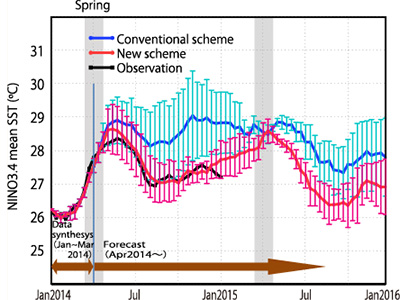A research team that includes Professor John Philip Matthews, Institute for Liberal Arts and Sciences, and Professor Emeritus Toshiyuki Awaji, has developed a new prediction scheme for the El Niño phenomenon based on the discovery of new types of tropical climate variation. Dr Shuhei Masuda, a Kyoto University alumnus and now Group Leader of the Research and Development Center for Global Change at the Japan Agency for Marine-Earth Science and Technology (JAMSTEC: Asahiko Taira, President) was the lead author. The work was carried out in collaboration with researchers from JAMSTEC.
"Improved prediction of the El Niño is urgently required because of its wide global impact through extreme weather events such as intense heat, drought, and heavy rain. This goal can never be achieved without better understanding of the mechanisms driving El Niño genesis," Dr Masuda said.
To tackle this challenge, the team analyzed new global climate-state estimations obtained by a state-of-the-art data assimilation technique on the "Earth Simulator". They reassessed El Niño energetics by focusing on the exchange of kinetic energy between the atmosphere and ocean, which significantly affects El Niño development.
Their results showed that the seasonal variability of one key component of the energy delivered by the atmosphere to the tropical ocean is modulated on pentadal (five year) to decadal timescales. They then developed a new coupled climate simulation technique which incorporates these long-term
influences directly and, as a result, generates both accurate hindcasts for the major historical El Niños on the Earth Simulator and more accurate predictions of El Niño beyond boreal spring.
Overall the work will contribute to a better understanding of climate fundamentals and further improvements in the predictability of the El Niño phenomenon.
Kyoto University co-author, Prof John Matthews, stated that "Strong El Niño events are like sirens warning us of the potential impacts of future climate change. Better prediction techniques, such as ours, need to be matched by improved surveillance and robust countermeasures."
The above results were posted in Nature Scientific Reports on 25 November (JST). This project was supported by the Ministry of Education, Culture, Sports, Science and Technology (MEXT) of Japan (Research Program on Climate Change Adaptation [RECCA] 10101028).


Notes
Data assimilation
This is a method of incorporating observational data into numerical simulation models. In our study, in particular, it refers to the synthesis of sparse observational data into a continuous equal-quality dataset by using numerical-model formalization. Data assimilation methods usually incorporate actual observational data into numerical simulation schemes to provide initial conditions for forecast experiments, since this approach leads to more accurate predictions.
Earth Simulator
Earth Simulator is a highly parallel vector supercomputer system of JAMSTEC.
Coupled climate simulation
This refers to simulation using a coupled atmosphere-ocean model. The model numerically calculates the temporal evolution of oceanic and atmospheric variables by taking into account, in a self-consistent fashion, the various coupling factors that govern the transfer of heat, mass and energy.



